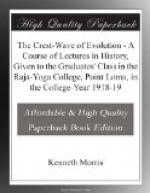Someone told me the other day what he had seen a couple of Chinamen do in a Californian garden. They had a flower-bed to plant, about forty feet long; and each a basket of seedlings to plant it with, and a slip of wood for a model, with mystic unintelligible signs inscribed thereon: WELCOME HOME in English capitals. One went to one end of the bed and the other to the other, and they began their planting. They made no measurements or calculations; used no rod or line; but just worked ahead till they met in the middle. When that happened, and the job was done, the bed was inscribed, in perfectly formed and proportioned English capitals made of young plants, WELCOME HOME. There was no crowding or omission. To account for it you have twenty-four centuries of Confucianism,—of Katherine Tingley’s doctrine of Middle Lines, the Balanced Life.
It is a very small thing; but it may help us to understand.
XII. TALES FROM A TAOIST TEACHER
Confucius died in 478: the year, it may be noted, in which Athens attained her hegemony: or just when the Greek Cycle thirteen decades was opening. Looking backward thirteen decades from that, we come to 608 B.C.; four years after which date, according to the usually accepted tradition, Laotse was born. Thus we find the cycle preceding that of Greece mainly occupied, in China, by the lives of the two great Teachers.
We should have seen by this time that these two lives were, so to say, parts of a single whole: co-ordinated spiritually, if not in an organization on this plane. Laotse, like H.P. Blavatsky, brought the Teachings; he illuminated the inner worlds. That was his work. We can see little of him as he accomplished it: and only the smallest fragment of his doctrine remains:—five thousand words, out of his whole long life. But since we have had in our own time an example of how these things are done, we may judge him and his mission by this analogy; also by the results. Then came Confucius, like Katherine Tingley, to link this wisdom with individual and national life. The teachings were there; and he had no need to restate them: he might take the great principles as already enounced. But every Teacher has his own method, and his need to accentuate this or that: so time and history have had most to say about the differences between these two. What Confucius had to do, and did, was to found his school, and show in the lives of his disciples, modeled under his hands, how the wisdom of the Ages (and of Laotse) can be made a living power in life and save the world.




